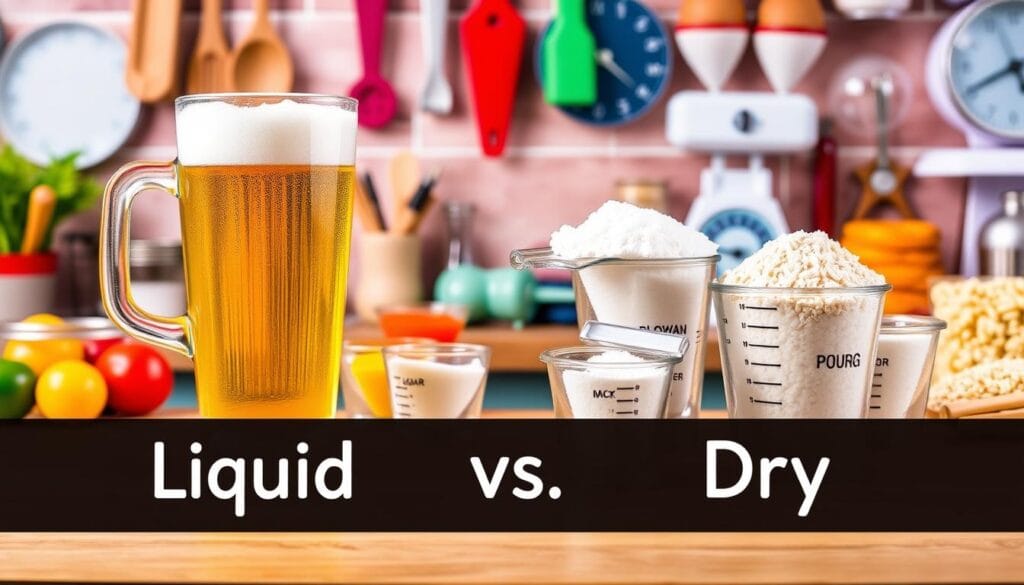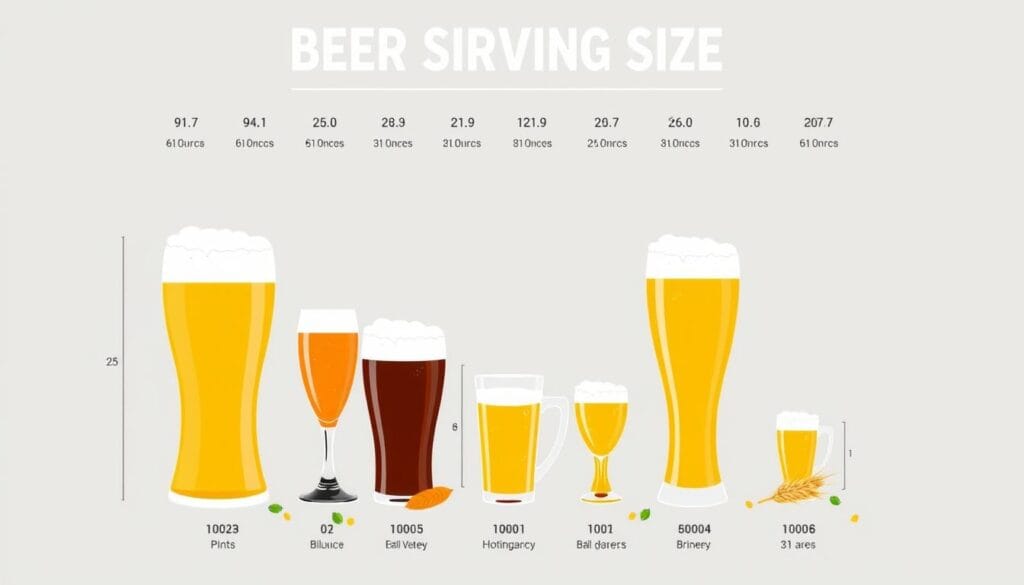Ever found yourself in your kitchen, recipe in hand, feeling lost over pint measurements? You’re not alone. Converting liquid measurements can turn even the most skilled home cook into a confused baker. They struggle to figure out how many ounces are in a pint.
Whether you’re making craft beer, baking a cake, or cooking a family recipe, knowing ounces to pints is key. The world of measurements is not just about numbers. It’s about precision, tradition, and the science behind every dish.
This guide will clear up pint measurements, covering regional differences, historical roots, and kitchen uses. We’ll look at US standard measurements and imperial variations. You’ll learn everything you need to know about this important volume unit.
how many ounces in a pint
Table of Contents
Key Takeaways
- US and UK pint measurements differ significantly
- Understanding liquid vs. dry measurement conversions
- Practical kitchen measurement techniques
- Historical context of pint measurements
- Essential conversion strategies for home cooks
Understanding Basic Measurement Units
Measurement units are key for accurate cooking, baking, and science. Exploring volume units and capacity conversions opens a world of imperial system units. These units have changed a lot over time.
The history of measurement is full of interesting changes. Ancient people made ways to measure liquids and dry ingredients. This helped create today’s measurement systems.
The Origin of Ounces
Ounces come from ancient Rome. They started as a part of a copper bar. Now, they are exact scientific measures. In 1959, the US and British Commonwealth set a standard dry ounce at 28.349523125 grams.
- Fluid ounces measure volume
- Dry ounces measure weight
- One fluid ounce equals about 29.57 milliliters
What Defines a Pint
A pint is 1/8th of a gallon, but it means different things in different systems. In the US, a liquid pint is 16 fluid ounces. An Imperial pint is 20 fluid ounces.
| Measurement System | Liquid Pint | Dry Pint |
|---|---|---|
| US Customary | 16 fluid ounces | 18.618 fluid ounces |
| Imperial | 20 fluid ounces | 20 fluid ounces |
Modern Measurement Standards
Today, measurement standards come from global work. The US system is unique, but the world is trying to make volume units and capacity conversions the same everywhere.
“A pint’s a pound the world round” – A classic kitchen adage highlighting measurement simplicity
How Many Ounces in a Pint
Understanding liquid measurements can be tricky, especially in cooking or baking. The ounces to pints conversion changes based on the ingredient type and measurement system.
In the United States, liquid measurements are straightforward. A standard liquid pint holds 16 fluid ounces. This rule applies to liquids like water, milk, and more.
- US Liquid Pint: 16 fluid ounces
- US Dry Pint: 18.6 fluid ounces
- Imperial (UK) Liquid Pint: 20 fluid ounces
Dry ingredients have a different story. A dry pint doesn’t always equal fluid ounces. For instance, a pint of blueberries weighs about 12 ounces. On the other hand, a pint of flour is roughly 18 fluid ounces.
“A pint’s a pound the world around” – An old cooking adage that helps remember measurement conversions
| Ingredient | Pint Weight/Volume |
|---|---|
| Water | 16 fluid ounces |
| Cottage Cheese | 16 fluid ounces |
| Grape Tomatoes | 11 ounces |
| Vodka | 16 fluid ounces |
Knowing these liquid measurement conversions can make cooking easier. It’s especially helpful when using international cookbooks or adjusting ingredient amounts.
The Difference Between US and Imperial Pints
Understanding volume units can be tricky, especially when exploring regional measurement differences between the US and Imperial systems. The variations in pint measurements might seem small, but they can significantly impact cooking, brewing, and other precise measurement needs.
Let’s dive into the fascinating world of imperial system units and how they differ across regions.
US Standard Measurements
In the United States, a pint follows a specific standard that distinguishes it from other measurement systems. Here are key characteristics of US volume units:
- 1 US pint = 16 fluid ounces
- Primarily used in cooking, beverages, and liquid measurements
- Slightly smaller volume compared to Imperial pints
Imperial System Variations
The Imperial system, established in 1824, offers a different approach to volume measurements. Its unique characteristics include:
- 1 Imperial pint = 20 fluid ounces
- Used in the United Kingdom and some Commonwealth countries
- Larger volume compared to US pints
Regional Differences Explained
The measurement variations stem from historical developments and independent measurement standards. To illustrate these differences, consider this comparative analysis:
| Measurement Aspect | US System | Imperial System |
|---|---|---|
| Fluid Ounce Volume | 29.5735 ml | 28.413 ml |
| Pint Volume | 473.176 ml | 568.261 ml |
| Primary Usage | United States | United Kingdom, Commonwealth |
Pro tip: When following international recipes, always double-check the measurement system to ensure accurate results!
“Measurements may differ, but precision is universal.” – Culinary Wisdom
Liquid vs. Dry Measurements
Knowing the difference between liquid and dry measurements is key for cooking well. They might look similar, but they’re not the same. This difference can greatly affect your cooking.

When you cook, every detail matters. Liquid measurements are about volume, while dry ones are about weight. This difference is crucial for a recipe’s success.
- Liquid pints contain 16 fluid ounces
- Dry pints weigh approximately 18.6 ounces
- Liquid measurements use fluid volume
- Dry measurements use weight
“Precision in measurement is the secret ingredient of great cooking” – Professional Chef’s Wisdom
Success in the kitchen comes from knowing these differences. A liquid pint and a dry pint are not the same. Using them interchangeably can ruin your dishes.
| Measurement Type | Volume | Weight |
|---|---|---|
| Liquid Pint | 16 fluid ounces | 16 fluid ounces |
| Dry Pint | 18.6 ounces | 16 dry ounces |
Both professional chefs and home cooks need to understand that capacity conversions vary. Each ingredient needs its own measurement method for accurate recipes.
Converting Pints to Other Common Measurements
Knowing how to convert volume units is key for cooking. It’s important for following recipes or trying new things in the kitchen. Learning to switch between different measurement systems can greatly improve your cooking.
Pints to Cups Conversion
Converting pints to cups is easy. One pint is always equal to 2 cups. This makes it simple to adjust recipes:
- 1 pint = 2 cups
- 2 pints = 4 cups
- 3 pints = 6 cups
- 4 pints = 8 cups
Pints to Quarts and Gallons
Knowing more about volume units helps with complex cooking. Here’s a quick guide to pint conversions:
| Measurement | Equivalent in Pints | Fluid Ounces |
|---|---|---|
| 1 Quart | 2 Pints | 32 fl oz |
| 1 Gallon | 8 Pints | 128 fl oz |
Metric System Equivalents
For international recipes, knowing metric conversions is crucial. Here are the main metric equivalents for pints:
- 1 US Pint ≈ 473 milliliters
- 1 Imperial Pint ≈ 568 milliliters
“Precision in measurement is the key to culinary success.” – Professional Chef
Learning these conversions will boost your cooking and baking. It ensures your dishes turn out great every time.
Beer and Beverage Measurements

Knowing how much to drink is key for bartending and enjoying beer. Beer comes in many sizes, each with its own story and meaning.
In the United States, there are standard beer sizes for everyone:
- 12-ounce can/bottle: Common in stores and bars
- 16-ounce pint: Great for draft beers and “tallboy” cans
- 22-ounce bomber: Best for craft beer lovers
- 32-ounce crowler: Perfect for draft beer to go
- 64-ounce growler: Ideal for sharing or big events
“Beer measurement is an art that combines precision and cultural tradition.”
Other countries have their own beer sizes. In Europe, you’ll find 11.2-ounce (330ml) and 16.9-ounce (500ml) bottles. They follow similar bartending rules as the US.
Beer styles also guide packaging choices. IPAs are canned to keep hops fresh. Stouts are often in larger bottles for sharing. Pilsners and wheat beers have their own packaging to keep quality high.
Remember, serving sizes affect your drinking experience. Knowing these sizes helps you choose wisely, whether at a bar, brewery, or home.
Kitchen Tools for Accurate Measurements
Precision is key in cooking and baking. The right kitchen tools can turn simple meals into amazing dishes. Choosing the best tools for measuring is essential for great results.
You have many options for accurate measurements in your kitchen. Knowing the strengths of each tool can improve your cooking.
Measuring Cups: Your Culinary Allies
Both professional chefs and home cooks use special measuring cups. The top tools include:
- Glass liquid measuring cups for exact fluid amounts
- Stainless steel dry measuring cups for precise ingredient portions
- Nested cup sets for easy storage and flexibility
Digital vs. Analog Measurement Tools
Today, we have two main ways to measure:
- Digital Scales: Give super-accurate weight readings
- Analog Scales: Classic and more budget-friendly choices
“Accuracy in measurements is the difference between good and exceptional cooking.” – Professional Chef
The Hudson Essentials Stainless Steel Measuring Cups and Anchor Hocking Glass Measuring Cups are top picks. When picking tools, think about durability, cleaning ease, and precision.
Common Cooking and Baking Conversions
Knowing how to measure ingredients is key for making great dishes. It’s important to understand how to convert between different units. This skill is useful for both home bakers and professional chefs.
Getting the measurements right is crucial in cooking and baking. The wrong conversion can ruin a recipe, especially when you’re adjusting the amount of ingredients.
Essential Kitchen Conversions
- 1 cup = 8 fluid ounces
- 1 pint = 2 cups (16 fluid ounces)
- 1 quart = 4 cups (32 fluid ounces)
- 1 gallon = 4 quarts (128 fluid ounces)
Baking needs even more precision. Precision is key in creating perfect pastries and baked goods.
| Measurement | US Volume | Metric Equivalent |
|---|---|---|
| 1 Teaspoon | 1 tsp | 5 mL |
| 1 Tablespoon | 3 teaspoons | 15 mL |
| 1/4 Cup | 4 tablespoons | 60 mL |
| 1 Cup | 16 tablespoons | 240 mL |
“Cooking is about passion, so it may look slightly temperamental in a way that it’s too assertive to the naked eye.” – Gordon Ramsay
Pro tip for recipe conversions: Always double-check your measurements and use reliable kitchen tools. Digital scales can provide the most accurate results for both dry and liquid ingredients.
When working with international recipes, remember that measurement systems vary. The United States uses a different standard compared to metric countries, so always verify your conversions before starting to cook.
Conclusion
Knowing how to measure pints is key for precise cooking and baking. It helps you understand the difference between US and Imperial systems. This knowledge lets you make dishes consistently tasty.
Now, you have the tools to measure accurately. Whether it’s an American recipe or something from abroad, you’re ready. Remember, liquids need volume measurements, but dry ingredients might be different.
Using these techniques makes you a better cook. Digital scales and precise cups are your friends. With these, you can tackle any recipe with confidence. Your skills in measuring pints ensure your dishes are perfect every time.
Mastering cooking measurements is about more than just numbers. It’s about making your kitchen a place of joy. By learning about pint measurements and how to convert them, you open up a world of possibilities. Every recipe becomes a chance to create something special.
FAQ
How many fluid ounces are in a US pint?
What’s the difference between US and Imperial pint measurements?
Are liquid and dry pint measurements the same?
How many pints are in a gallon?
How do I convert pints to milliliters?
What’s the standard pint size for beer?
How can I ensure accurate measurement conversions?
Why do measurement systems differ between countries?
What tools do I need for accurate pint measurements?
How can I convert between cups and pints?
Leave us a comment if you like the recipe
There are no reviews yet. Be the first one to write one.
